ACC00145 - Commonwealth Bank Annual Report: Social Accountability GPFR
VerifiedAdded on 2023/06/04
|10
|2134
|362
Report
AI Summary
This report analyzes the Commonwealth Bank's annual report with a focus on social accountability and compliance with Australian Accounting Standards Board (AASB) and International Financial Reporting Standards (IFRS). It assesses the bank's financial reporting practices, including disclosures related to customer base, shareholding, dividends, and technology adoption. The report highlights the importance of AASB in regulating financial reporting and ensuring transparency for stakeholders. It further examines the impact of disclosures on market perception and regulatory compliance, concluding that adherence to IFRS and AASB is crucial for social accountability and effective general-purpose financial reporting. This document is available on Desklib, where students can find a wide range of solved assignments and study resources.
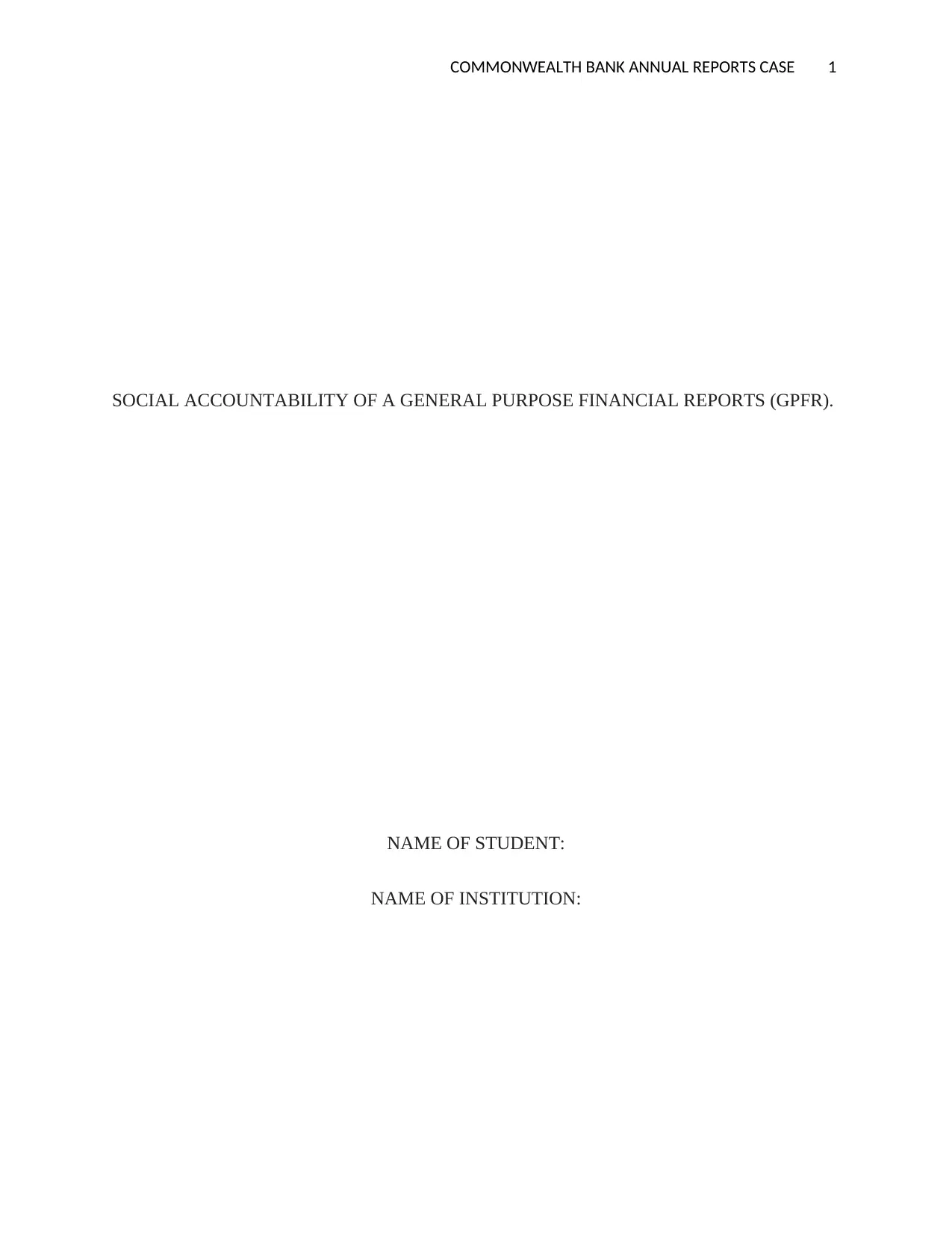
COMMONWEALTH BANK ANNUAL REPORTS CASE 1
SOCIAL ACCOUNTABILITY OF A GENERAL PURPOSE FINANCIAL REPORTS (GPFR).
NAME OF STUDENT:
NAME OF INSTITUTION:
SOCIAL ACCOUNTABILITY OF A GENERAL PURPOSE FINANCIAL REPORTS (GPFR).
NAME OF STUDENT:
NAME OF INSTITUTION:
Paraphrase This Document
Need a fresh take? Get an instant paraphrase of this document with our AI Paraphraser

COMMONWEALTH BANK ANNUAL REPORTS CASE 2
Abstract.
In social accountability concept, the applicability of the accounting standards and its usage buy
listed entities. The disclosure requirement and importance to the entity and related disclosures.
All listed entities are required by international financial reporting standards to disclose and
prepare financial statements periodically. The financial statements of an entity for a complete
financial report must comprise the main four components that are balance sheet, income
statements, statements of cash flows and statements of retained earnings to be deemed complete.
The Australian accounting standards board (AASBs) further improves to a high level the
measurements of uncertainty in the information provided by setting common guidelines to be
followed when preparing the financial reports. The quality of information presented in an annual
reports influences the stakeholders’ decisions to mitigate more information or invest in the entity.
The disclosure of accurate, timely and comprehensive information determines the success of a
listed entity in the market.
Abstract.
In social accountability concept, the applicability of the accounting standards and its usage buy
listed entities. The disclosure requirement and importance to the entity and related disclosures.
All listed entities are required by international financial reporting standards to disclose and
prepare financial statements periodically. The financial statements of an entity for a complete
financial report must comprise the main four components that are balance sheet, income
statements, statements of cash flows and statements of retained earnings to be deemed complete.
The Australian accounting standards board (AASBs) further improves to a high level the
measurements of uncertainty in the information provided by setting common guidelines to be
followed when preparing the financial reports. The quality of information presented in an annual
reports influences the stakeholders’ decisions to mitigate more information or invest in the entity.
The disclosure of accurate, timely and comprehensive information determines the success of a
listed entity in the market.
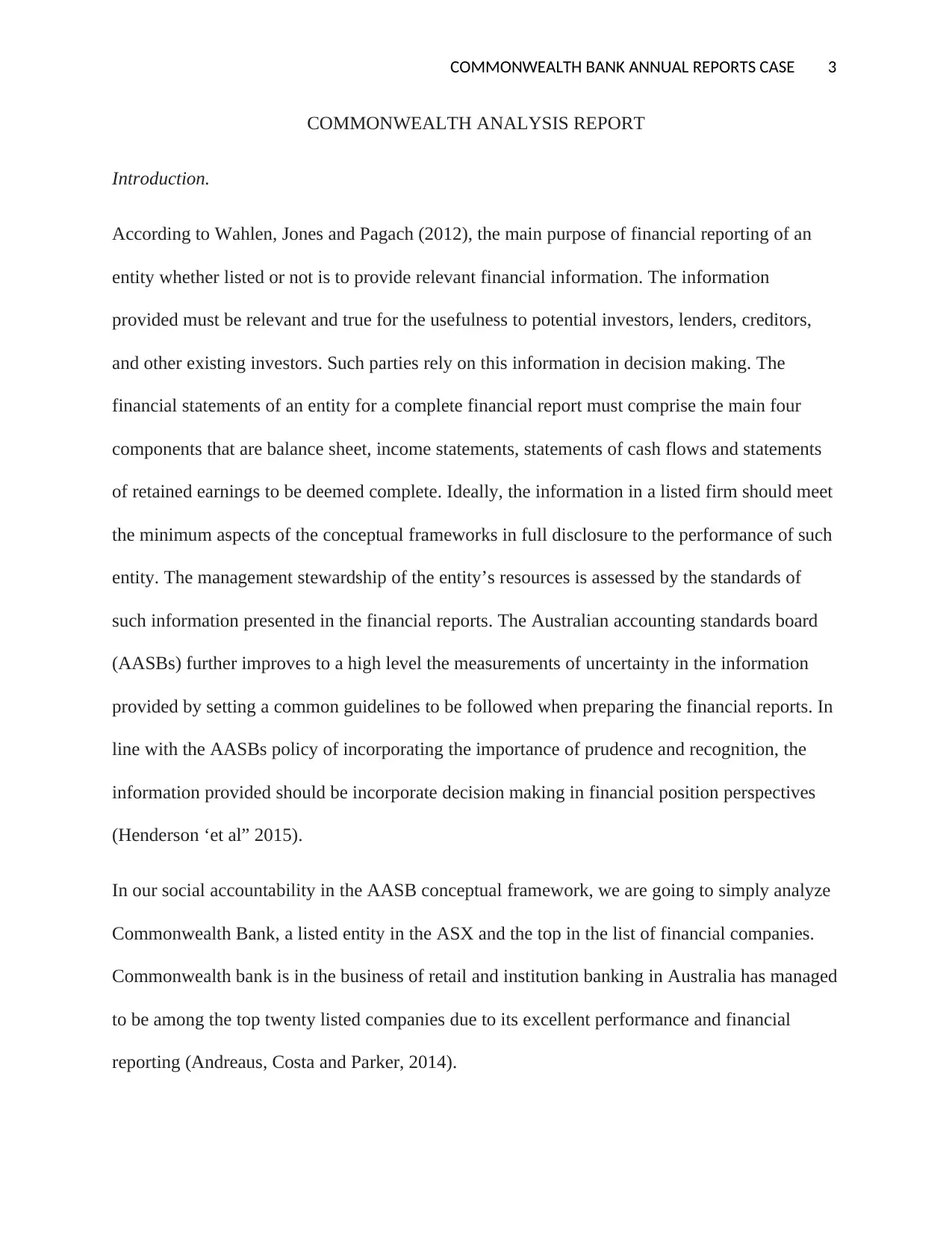
COMMONWEALTH BANK ANNUAL REPORTS CASE 3
COMMONWEALTH ANALYSIS REPORT
Introduction.
According to Wahlen, Jones and Pagach (2012), the main purpose of financial reporting of an
entity whether listed or not is to provide relevant financial information. The information
provided must be relevant and true for the usefulness to potential investors, lenders, creditors,
and other existing investors. Such parties rely on this information in decision making. The
financial statements of an entity for a complete financial report must comprise the main four
components that are balance sheet, income statements, statements of cash flows and statements
of retained earnings to be deemed complete. Ideally, the information in a listed firm should meet
the minimum aspects of the conceptual frameworks in full disclosure to the performance of such
entity. The management stewardship of the entity’s resources is assessed by the standards of
such information presented in the financial reports. The Australian accounting standards board
(AASBs) further improves to a high level the measurements of uncertainty in the information
provided by setting a common guidelines to be followed when preparing the financial reports. In
line with the AASBs policy of incorporating the importance of prudence and recognition, the
information provided should be incorporate decision making in financial position perspectives
(Henderson ‘et al” 2015).
In our social accountability in the AASB conceptual framework, we are going to simply analyze
Commonwealth Bank, a listed entity in the ASX and the top in the list of financial companies.
Commonwealth bank is in the business of retail and institution banking in Australia has managed
to be among the top twenty listed companies due to its excellent performance and financial
reporting (Andreaus, Costa and Parker, 2014).
COMMONWEALTH ANALYSIS REPORT
Introduction.
According to Wahlen, Jones and Pagach (2012), the main purpose of financial reporting of an
entity whether listed or not is to provide relevant financial information. The information
provided must be relevant and true for the usefulness to potential investors, lenders, creditors,
and other existing investors. Such parties rely on this information in decision making. The
financial statements of an entity for a complete financial report must comprise the main four
components that are balance sheet, income statements, statements of cash flows and statements
of retained earnings to be deemed complete. Ideally, the information in a listed firm should meet
the minimum aspects of the conceptual frameworks in full disclosure to the performance of such
entity. The management stewardship of the entity’s resources is assessed by the standards of
such information presented in the financial reports. The Australian accounting standards board
(AASBs) further improves to a high level the measurements of uncertainty in the information
provided by setting a common guidelines to be followed when preparing the financial reports. In
line with the AASBs policy of incorporating the importance of prudence and recognition, the
information provided should be incorporate decision making in financial position perspectives
(Henderson ‘et al” 2015).
In our social accountability in the AASB conceptual framework, we are going to simply analyze
Commonwealth Bank, a listed entity in the ASX and the top in the list of financial companies.
Commonwealth bank is in the business of retail and institution banking in Australia has managed
to be among the top twenty listed companies due to its excellent performance and financial
reporting (Andreaus, Costa and Parker, 2014).
⊘ This is a preview!⊘
Do you want full access?
Subscribe today to unlock all pages.

Trusted by 1+ million students worldwide

COMMONWEALTH BANK ANNUAL REPORTS CASE 4
Importance of AASB.
The IFRS recommends that any accounting board should embrace the use of the accounting
stands in their daily reporting. The accounting practitioners that is the accountant are guided by
the set standards set such bodies. Like any other accounting board, AASB is necessary and
important to the regulation and management of the profession in entities for the entity to provide
relevant and through information. Accounting standards help the entity to prepare financial
statements that provide through the financial information in a manner that any stakeholder can
understand clearly (Gruber S. 2014).
Types of information provided in the Commonwealth 2017 annual report.
The banks Chairman’s reports analysis.
The Commonwealth bank chairman starts by giving out summary overall reports. He had
indicated that in 2017, the bank served a total of 16.6 million customers. The chairman further
states that the bank spent $197 billion to individual and business lending as an aim to help them
grow economically and home ownership Available at: (http://republicast.com/ Accessed
22/09/2018).
Commonwealth Customers Analysis.
In 2017 the commonwealth bank had managed to bring in board 16.6M customers who hold
bank accounts with them. In the financial reports, the bank indicates that 6.2m of its customers
are digitally enabled customers (http://www.republicast.com)
Importance of AASB.
The IFRS recommends that any accounting board should embrace the use of the accounting
stands in their daily reporting. The accounting practitioners that is the accountant are guided by
the set standards set such bodies. Like any other accounting board, AASB is necessary and
important to the regulation and management of the profession in entities for the entity to provide
relevant and through information. Accounting standards help the entity to prepare financial
statements that provide through the financial information in a manner that any stakeholder can
understand clearly (Gruber S. 2014).
Types of information provided in the Commonwealth 2017 annual report.
The banks Chairman’s reports analysis.
The Commonwealth bank chairman starts by giving out summary overall reports. He had
indicated that in 2017, the bank served a total of 16.6 million customers. The chairman further
states that the bank spent $197 billion to individual and business lending as an aim to help them
grow economically and home ownership Available at: (http://republicast.com/ Accessed
22/09/2018).
Commonwealth Customers Analysis.
In 2017 the commonwealth bank had managed to bring in board 16.6M customers who hold
bank accounts with them. In the financial reports, the bank indicates that 6.2m of its customers
are digitally enabled customers (http://www.republicast.com)
Paraphrase This Document
Need a fresh take? Get an instant paraphrase of this document with our AI Paraphraser

COMMONWEALTH BANK ANNUAL REPORTS CASE 5
Commonwealth Shareholding Analysis
As at 2017 annual report, the bank has more than 800,000 shareholders who have invested in its
shareholdings. The bank still maintains and manages other none regular shareholders who hold
the CBA shares account through the superannuation fund kit. As a tier 1 bank, commonwealth
bank was able to hit the $9m plus mark profit after tax and further managed to pay the dividend
at $4.29 per share Available at: (http://republicast.com/ Accessed 22/09/2018).
Commonwealth Dividends Analysis.
In the year ended 2017, the bank paid a total of $7.4bn as dividends from 75% of the total
returned profits to its shareholders. From the 800,000 shareholders, each shareholder was
expected to receive $3,820 directly in dividends Available at: (http://republicast.com/ Accessed
22/09/2018).
The banks Technology Report analysis.
In this era of technology, the bank has embraced fully compliant with the use of world-class
technology to meet the customers’ needs. Commonwealth has embraced the use of real-time core
banking system, representing the number one bank in Australia and also in the world to go real-
time in their daily banking transactions. Due to the huge customer number, the commonwealth
has incorporated in its bank data management the use of a financial app which so far has a total
of 30 million users as (https://www.commbank.com.au/).
According to the Commonwealth website annual report the bank financial app has covered at
least 6.2 million active online users in a single minute. With the continuing innovation in the use
of analytics data capabilities, the bank has embraced the security of its clients and own data
Commonwealth Shareholding Analysis
As at 2017 annual report, the bank has more than 800,000 shareholders who have invested in its
shareholdings. The bank still maintains and manages other none regular shareholders who hold
the CBA shares account through the superannuation fund kit. As a tier 1 bank, commonwealth
bank was able to hit the $9m plus mark profit after tax and further managed to pay the dividend
at $4.29 per share Available at: (http://republicast.com/ Accessed 22/09/2018).
Commonwealth Dividends Analysis.
In the year ended 2017, the bank paid a total of $7.4bn as dividends from 75% of the total
returned profits to its shareholders. From the 800,000 shareholders, each shareholder was
expected to receive $3,820 directly in dividends Available at: (http://republicast.com/ Accessed
22/09/2018).
The banks Technology Report analysis.
In this era of technology, the bank has embraced fully compliant with the use of world-class
technology to meet the customers’ needs. Commonwealth has embraced the use of real-time core
banking system, representing the number one bank in Australia and also in the world to go real-
time in their daily banking transactions. Due to the huge customer number, the commonwealth
has incorporated in its bank data management the use of a financial app which so far has a total
of 30 million users as (https://www.commbank.com.au/).
According to the Commonwealth website annual report the bank financial app has covered at
least 6.2 million active online users in a single minute. With the continuing innovation in the use
of analytics data capabilities, the bank has embraced the security of its clients and own data
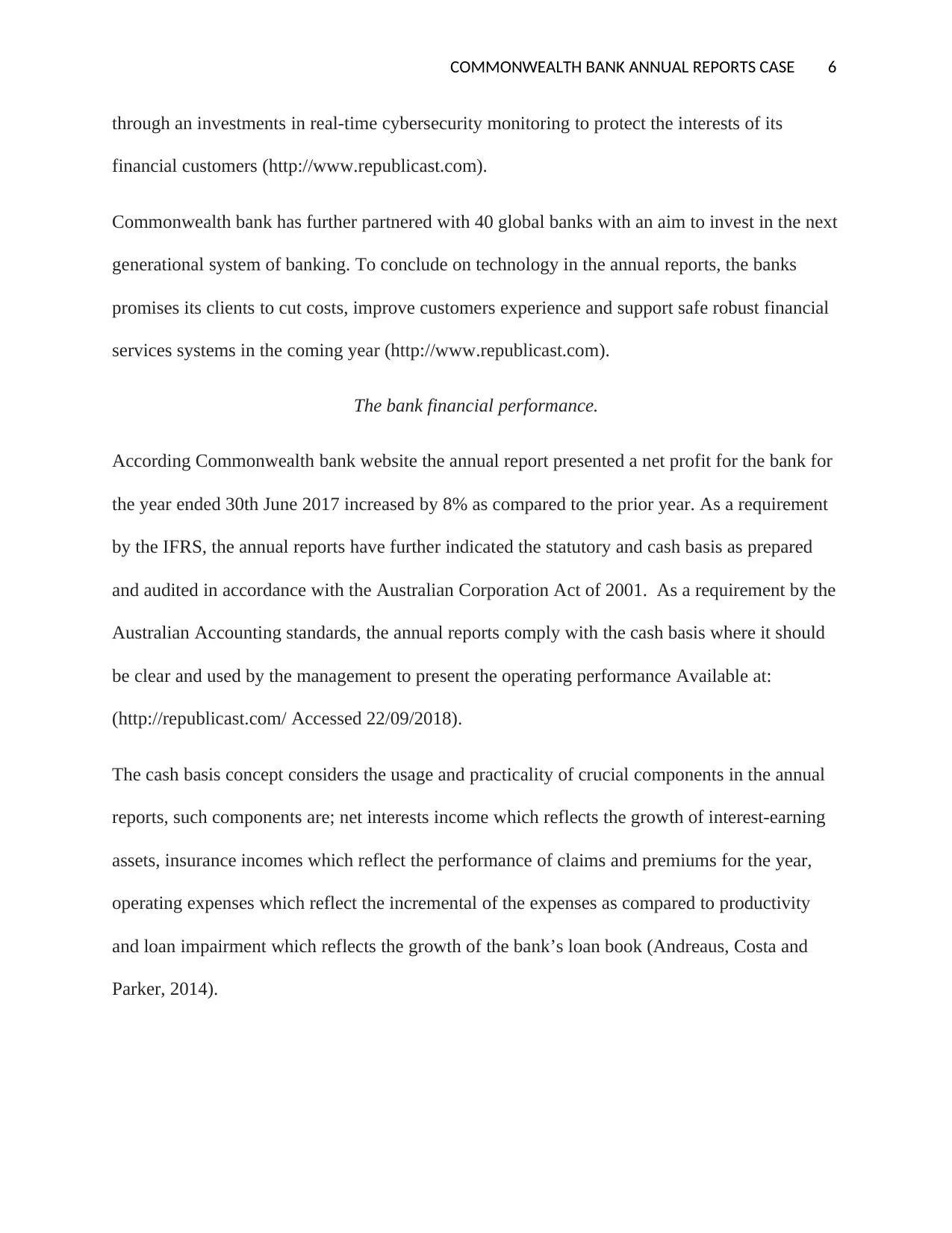
COMMONWEALTH BANK ANNUAL REPORTS CASE 6
through an investments in real-time cybersecurity monitoring to protect the interests of its
financial customers (http://www.republicast.com).
Commonwealth bank has further partnered with 40 global banks with an aim to invest in the next
generational system of banking. To conclude on technology in the annual reports, the banks
promises its clients to cut costs, improve customers experience and support safe robust financial
services systems in the coming year (http://www.republicast.com).
The bank financial performance.
According Commonwealth bank website the annual report presented a net profit for the bank for
the year ended 30th June 2017 increased by 8% as compared to the prior year. As a requirement
by the IFRS, the annual reports have further indicated the statutory and cash basis as prepared
and audited in accordance with the Australian Corporation Act of 2001. As a requirement by the
Australian Accounting standards, the annual reports comply with the cash basis where it should
be clear and used by the management to present the operating performance Available at:
(http://republicast.com/ Accessed 22/09/2018).
The cash basis concept considers the usage and practicality of crucial components in the annual
reports, such components are; net interests income which reflects the growth of interest-earning
assets, insurance incomes which reflect the performance of claims and premiums for the year,
operating expenses which reflect the incremental of the expenses as compared to productivity
and loan impairment which reflects the growth of the bank’s loan book (Andreaus, Costa and
Parker, 2014).
through an investments in real-time cybersecurity monitoring to protect the interests of its
financial customers (http://www.republicast.com).
Commonwealth bank has further partnered with 40 global banks with an aim to invest in the next
generational system of banking. To conclude on technology in the annual reports, the banks
promises its clients to cut costs, improve customers experience and support safe robust financial
services systems in the coming year (http://www.republicast.com).
The bank financial performance.
According Commonwealth bank website the annual report presented a net profit for the bank for
the year ended 30th June 2017 increased by 8% as compared to the prior year. As a requirement
by the IFRS, the annual reports have further indicated the statutory and cash basis as prepared
and audited in accordance with the Australian Corporation Act of 2001. As a requirement by the
Australian Accounting standards, the annual reports comply with the cash basis where it should
be clear and used by the management to present the operating performance Available at:
(http://republicast.com/ Accessed 22/09/2018).
The cash basis concept considers the usage and practicality of crucial components in the annual
reports, such components are; net interests income which reflects the growth of interest-earning
assets, insurance incomes which reflect the performance of claims and premiums for the year,
operating expenses which reflect the incremental of the expenses as compared to productivity
and loan impairment which reflects the growth of the bank’s loan book (Andreaus, Costa and
Parker, 2014).
⊘ This is a preview!⊘
Do you want full access?
Subscribe today to unlock all pages.

Trusted by 1+ million students worldwide
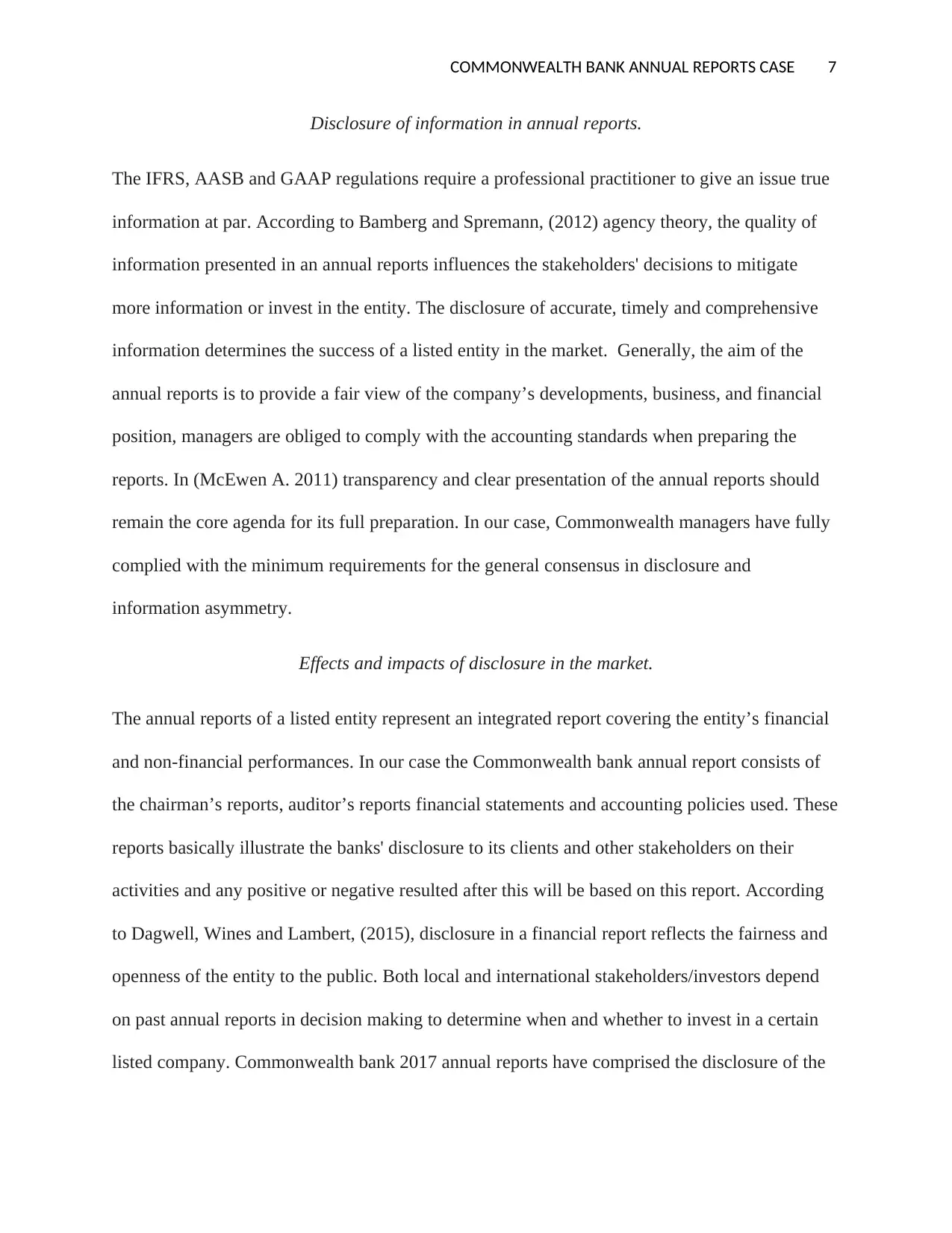
COMMONWEALTH BANK ANNUAL REPORTS CASE 7
Disclosure of information in annual reports.
The IFRS, AASB and GAAP regulations require a professional practitioner to give an issue true
information at par. According to Bamberg and Spremann, (2012) agency theory, the quality of
information presented in an annual reports influences the stakeholders' decisions to mitigate
more information or invest in the entity. The disclosure of accurate, timely and comprehensive
information determines the success of a listed entity in the market. Generally, the aim of the
annual reports is to provide a fair view of the company’s developments, business, and financial
position, managers are obliged to comply with the accounting standards when preparing the
reports. In (McEwen A. 2011) transparency and clear presentation of the annual reports should
remain the core agenda for its full preparation. In our case, Commonwealth managers have fully
complied with the minimum requirements for the general consensus in disclosure and
information asymmetry.
Effects and impacts of disclosure in the market.
The annual reports of a listed entity represent an integrated report covering the entity’s financial
and non-financial performances. In our case the Commonwealth bank annual report consists of
the chairman’s reports, auditor’s reports financial statements and accounting policies used. These
reports basically illustrate the banks' disclosure to its clients and other stakeholders on their
activities and any positive or negative resulted after this will be based on this report. According
to Dagwell, Wines and Lambert, (2015), disclosure in a financial report reflects the fairness and
openness of the entity to the public. Both local and international stakeholders/investors depend
on past annual reports in decision making to determine when and whether to invest in a certain
listed company. Commonwealth bank 2017 annual reports have comprised the disclosure of the
Disclosure of information in annual reports.
The IFRS, AASB and GAAP regulations require a professional practitioner to give an issue true
information at par. According to Bamberg and Spremann, (2012) agency theory, the quality of
information presented in an annual reports influences the stakeholders' decisions to mitigate
more information or invest in the entity. The disclosure of accurate, timely and comprehensive
information determines the success of a listed entity in the market. Generally, the aim of the
annual reports is to provide a fair view of the company’s developments, business, and financial
position, managers are obliged to comply with the accounting standards when preparing the
reports. In (McEwen A. 2011) transparency and clear presentation of the annual reports should
remain the core agenda for its full preparation. In our case, Commonwealth managers have fully
complied with the minimum requirements for the general consensus in disclosure and
information asymmetry.
Effects and impacts of disclosure in the market.
The annual reports of a listed entity represent an integrated report covering the entity’s financial
and non-financial performances. In our case the Commonwealth bank annual report consists of
the chairman’s reports, auditor’s reports financial statements and accounting policies used. These
reports basically illustrate the banks' disclosure to its clients and other stakeholders on their
activities and any positive or negative resulted after this will be based on this report. According
to Dagwell, Wines and Lambert, (2015), disclosure in a financial report reflects the fairness and
openness of the entity to the public. Both local and international stakeholders/investors depend
on past annual reports in decision making to determine when and whether to invest in a certain
listed company. Commonwealth bank 2017 annual reports have comprised the disclosure of the
Paraphrase This Document
Need a fresh take? Get an instant paraphrase of this document with our AI Paraphraser
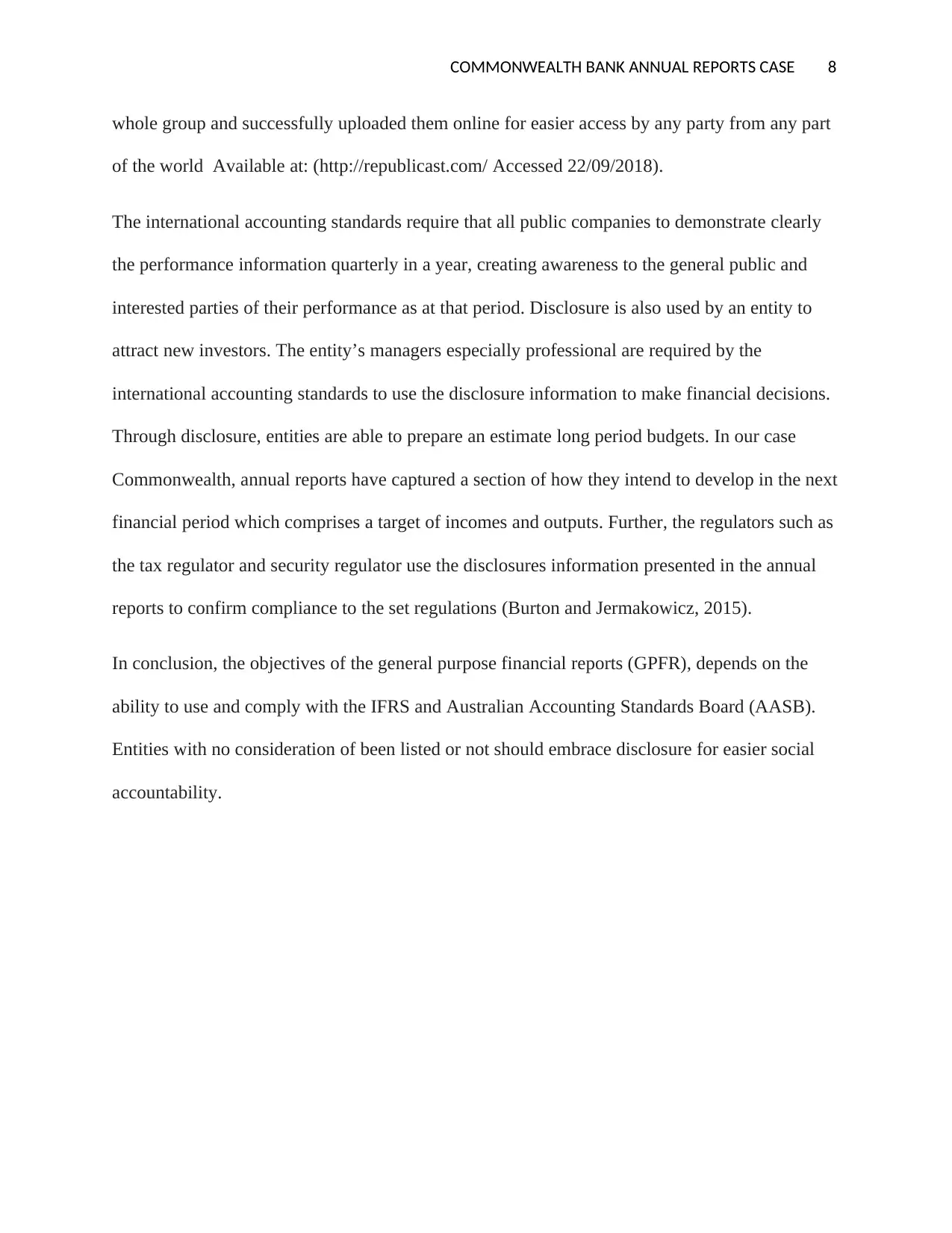
COMMONWEALTH BANK ANNUAL REPORTS CASE 8
whole group and successfully uploaded them online for easier access by any party from any part
of the world Available at: (http://republicast.com/ Accessed 22/09/2018).
The international accounting standards require that all public companies to demonstrate clearly
the performance information quarterly in a year, creating awareness to the general public and
interested parties of their performance as at that period. Disclosure is also used by an entity to
attract new investors. The entity’s managers especially professional are required by the
international accounting standards to use the disclosure information to make financial decisions.
Through disclosure, entities are able to prepare an estimate long period budgets. In our case
Commonwealth, annual reports have captured a section of how they intend to develop in the next
financial period which comprises a target of incomes and outputs. Further, the regulators such as
the tax regulator and security regulator use the disclosures information presented in the annual
reports to confirm compliance to the set regulations (Burton and Jermakowicz, 2015).
In conclusion, the objectives of the general purpose financial reports (GPFR), depends on the
ability to use and comply with the IFRS and Australian Accounting Standards Board (AASB).
Entities with no consideration of been listed or not should embrace disclosure for easier social
accountability.
whole group and successfully uploaded them online for easier access by any party from any part
of the world Available at: (http://republicast.com/ Accessed 22/09/2018).
The international accounting standards require that all public companies to demonstrate clearly
the performance information quarterly in a year, creating awareness to the general public and
interested parties of their performance as at that period. Disclosure is also used by an entity to
attract new investors. The entity’s managers especially professional are required by the
international accounting standards to use the disclosure information to make financial decisions.
Through disclosure, entities are able to prepare an estimate long period budgets. In our case
Commonwealth, annual reports have captured a section of how they intend to develop in the next
financial period which comprises a target of incomes and outputs. Further, the regulators such as
the tax regulator and security regulator use the disclosures information presented in the annual
reports to confirm compliance to the set regulations (Burton and Jermakowicz, 2015).
In conclusion, the objectives of the general purpose financial reports (GPFR), depends on the
ability to use and comply with the IFRS and Australian Accounting Standards Board (AASB).
Entities with no consideration of been listed or not should embrace disclosure for easier social
accountability.
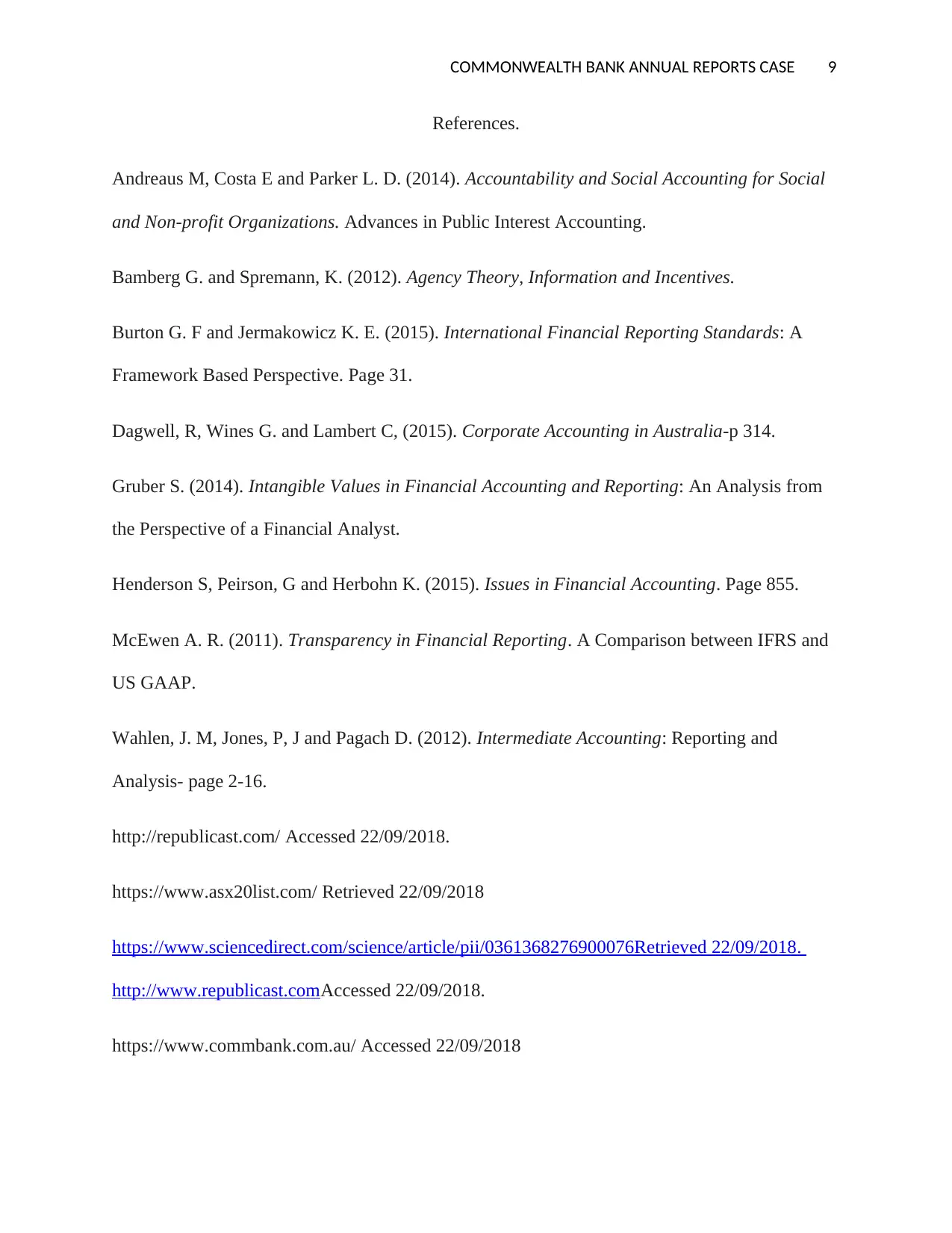
COMMONWEALTH BANK ANNUAL REPORTS CASE 9
References.
Andreaus M, Costa E and Parker L. D. (2014). Accountability and Social Accounting for Social
and Non-profit Organizations. Advances in Public Interest Accounting.
Bamberg G. and Spremann, K. (2012). Agency Theory, Information and Incentives.
Burton G. F and Jermakowicz K. E. (2015). International Financial Reporting Standards: A
Framework Based Perspective. Page 31.
Dagwell, R, Wines G. and Lambert C, (2015). Corporate Accounting in Australia-p 314.
Gruber S. (2014). Intangible Values in Financial Accounting and Reporting: An Analysis from
the Perspective of a Financial Analyst.
Henderson S, Peirson, G and Herbohn K. (2015). Issues in Financial Accounting. Page 855.
McEwen A. R. (2011). Transparency in Financial Reporting. A Comparison between IFRS and
US GAAP.
Wahlen, J. M, Jones, P, J and Pagach D. (2012). Intermediate Accounting: Reporting and
Analysis- page 2-16.
http://republicast.com/ Accessed 22/09/2018.
https://www.asx20list.com/ Retrieved 22/09/2018
https://www.sciencedirect.com/science/article/pii/0361368276900076Retrieved 22/09/2018.
http://www.republicast.comAccessed 22/09/2018.
https://www.commbank.com.au/ Accessed 22/09/2018
References.
Andreaus M, Costa E and Parker L. D. (2014). Accountability and Social Accounting for Social
and Non-profit Organizations. Advances in Public Interest Accounting.
Bamberg G. and Spremann, K. (2012). Agency Theory, Information and Incentives.
Burton G. F and Jermakowicz K. E. (2015). International Financial Reporting Standards: A
Framework Based Perspective. Page 31.
Dagwell, R, Wines G. and Lambert C, (2015). Corporate Accounting in Australia-p 314.
Gruber S. (2014). Intangible Values in Financial Accounting and Reporting: An Analysis from
the Perspective of a Financial Analyst.
Henderson S, Peirson, G and Herbohn K. (2015). Issues in Financial Accounting. Page 855.
McEwen A. R. (2011). Transparency in Financial Reporting. A Comparison between IFRS and
US GAAP.
Wahlen, J. M, Jones, P, J and Pagach D. (2012). Intermediate Accounting: Reporting and
Analysis- page 2-16.
http://republicast.com/ Accessed 22/09/2018.
https://www.asx20list.com/ Retrieved 22/09/2018
https://www.sciencedirect.com/science/article/pii/0361368276900076Retrieved 22/09/2018.
http://www.republicast.comAccessed 22/09/2018.
https://www.commbank.com.au/ Accessed 22/09/2018
⊘ This is a preview!⊘
Do you want full access?
Subscribe today to unlock all pages.

Trusted by 1+ million students worldwide

COMMONWEALTH BANK ANNUAL REPORTS CASE
10
10
1 out of 10
Related Documents
Your All-in-One AI-Powered Toolkit for Academic Success.
+13062052269
info@desklib.com
Available 24*7 on WhatsApp / Email
![[object Object]](/_next/static/media/star-bottom.7253800d.svg)
Unlock your academic potential
Copyright © 2020–2025 A2Z Services. All Rights Reserved. Developed and managed by ZUCOL.





